
Science Collaborations
Beacon-JWST
Beacon (Bias-free Extragalactic Analysis for Cosmic Origins with NIRCam) is a JWST pure-parallel imaging survey awarded 600 hours during Cycle 2 to address fundamental questions in extragalactic astronomy: What are the properties of the first galaxies? When did they form? How did galaxies acquire mass, evolve in structure, and quench star formation? Beacon will build a large, unbiased sample of the universe across 100 independent sightlines (~0.3 sq deg total area), minimizing cosmic variance to achieve a comprehensive census of early galaxies. Our NIRCam imaging spans 8+ bands, providing uninterrupted spectral coverage from 0.8 to 5 microns. This allows for robust photometric redshift determination and physical property analysis of sources at redshifts z ~ 2 to z > 10 through spectral energy distribution (SED) modeling.
More Information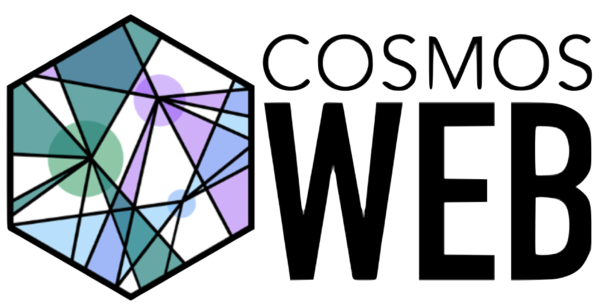
COSMOS-Web
COSMOS-Web
COSMOS-Web (PID: 1727) is a 255 hour wide-field Cycle 1 JWST treasury program that maps a contiguous 0.6 deg2 area with deep NIRCam imaging in 4 filters (F115W, F150W, F277W, and F444W) and a non-contiguous 0.2 deg2 area with MIRI in parallel. COSMOS-Web builds on the rich heritage of multiwavelength observations and data products available in the COSMOS field and will contain about a million galaxies across cosmic time. The survey will be completed by the end of 2023. The three primary science drivers of COSMOS-Web are to (1) Revolutionize our understanding of reionization's spatial distribution, environments, and drivers at early stages by detecting thousands of galaxies in the epoch of reionization (6<z<11) on scales large enough to mitigate cosmic variance; (2) Enable the identification and characterization of massive galaxies in the first two billion years, including the rarest quiescent galaxies at z > 4, and allow us to constrain the formation and evolution of early massive galaxies; and (3) Directly measure the evolution of the stellar mass to halo mass relation (SMHR) out to z ~ 2.5 and its variance with galaxies' star formation histories and morphologies.
More Information
GOALS
Great Observatories All-sky LIRG Survey
The Great Observatories All-sky LIRG Survey (GOALS) combines imaging and spectroscopic data from NASA/ESA's Spitzer, Hubble, Herschel, Chandra, NuSTAR, GALEX and Webb observatories, together with ground-based data from Keck, ALMA, VLT, JVLA and others, in a comprehensive, multi-wavelength study of over 200 of the most luminous infrared galaxies in the local Universe.
More Information
PASSAGE
Parallel Application of Slitless Spectroscopy to Analyze Galaxy Evolution
A wide field pure-parallel survey of emission-line galaxies spanning a wide range of cosmic time. With up to 600 hours of parallel JWST/NIRISS observations in Cycle 1, PASSAGE will spectroscopically discover many dozens of the brightest Ly-alpha line emitters in the reionization epoch, and also detect Ly-break galaxies independent of their Ly-alpha lines. This will provide the first unbiased determination of the EW(Ly-a) distribution, and potentially evidence for ionized bubbles. PASSAGE will also obtain stellar abundances in bright galaxies, and a census of brown dwarfs deep into the Galactic halo.
More Information
RAPID PIT
Roman Alerts Promptly from Image Differencing
RAPID (Roman Alerts Promptly from Image Differencing) is a Project Infrastructure Team for the Nancy Grace Roman Space Telescope. The Astro2020 Decadal Survey identified time-domain and multi-messenger science as a high priority. RAPID will enable a wide suite of dynamic-sky science for Roman. The RAPID team has experience providing services to the global time-domain community and will leverage previous work on other projects, particularly the Zwicky Transient Facility. The Principal Investigator for RAPID is Professor Mansi Kasliwal (Caltech). The primary development work for RAPID will be performed at IPAC.
More Information
Roman GRS PIT
Roman Galaxy Redshift Survey Project Infrastructure Team
The Roman Galaxy Redshift Survey Project Infrastructure Team (GRS PIT) develops and maintains the infrastructural tools and capabilities needed to address the mission objective for the Roman GRS and to support community science collaborations. We work closely with the Roman project, and partner with the Science Centers, providing all necessary support to ensure mission success. The PI, Yun Wang is a scientist at IPAC, as are several co-Is and collaborators on the project.
More Information
Roman HLIS Cosmology PIT
Roman Project Infrastructure Team: Cosmology with the Roman High Latitude Imaging Survey
The Nancy Grace Roman Space Telescope will be one of the most powerful facilities for weak lensing cosmology ever built, with the angular resolution, stability, and infrared sensitivity afforded by space-based observations. Forecasts imply that the weak gravitational lensing (WL) in a ~2000 sq. deg. high latitude imaging survey (HLIS) with Roman can measure the amplitude of matter fluctuations with an order of magnitude improvement in precision over current measurements. Delivering on this promise is an enormous challenge, requiring comparable improvements both the control of instrumental and astrophysical systematics, and the accuracy of model predictions. Our program of infrastructure development will enable the Roman HLIS to achieve its extraordinary cosmological potential, while simultaneously providing unprecedented volumes of exquisite data for an extensive range of astrophysical investigations. The PI of this PIT is Olivier Dore (JPL). Dan Masters from IPAC will focus on redshift measurement and calibration.
More InformationActive Science Collaborations

ALPINE
ALMA Large Program to Investigate C+ at Early Times
ALPINE (the ALMA Large Program to Investigate C+ at Early Times) is a 70 hour survey with the Atacama Large Millimeter Array (ALMA). The survey measures the far-infrared properties of 118 galaxies in the early Universe. IPAC scientist Andreas Faisst is the U.S. Lead PI, responsible for ancillary data management.
More Information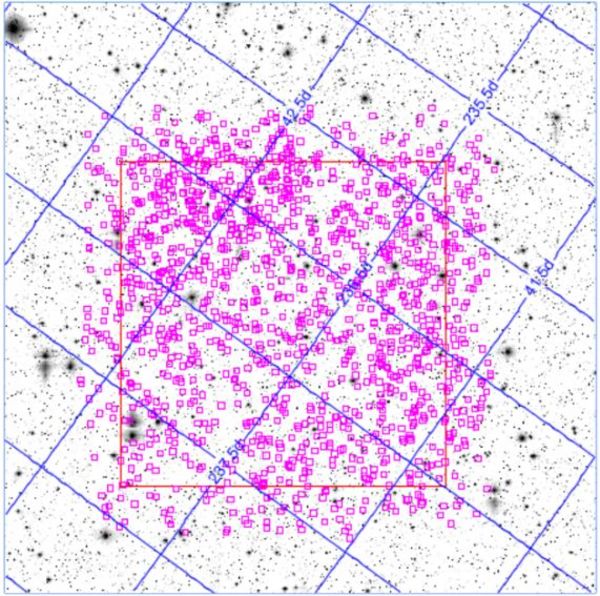
COSMOS
Cosmic Evolution Survey
The Cosmic Evolution Survey (COSMOS) is an astronomical survey designed to probe the formation and evolution of galaxies as a function of both cosmic time (redshift) and the local galaxy environment. The survey covers a 2 square degree equatorial field with imaging by most of the major space-based telescopes and a number of large ground based telescopes, with many ongoing surveys. Over 2 million galaxies are detected, spanning 75% of the age of the Universe. The COSMOS survey involves more than 100 scientists in a dozen countries. The primary goal of COSMOS is to study the relationship between large scale structure (LSS) in the universe and the formation of galaxies, dark matter, and nuclear activity in galaxies. This includes a careful analysis of the dependence of galaxy evolution on environment. The wide field of coverage of COSMOS will sample a larger range of LSS than any previous HST survey. The COSMOS team includes many IPAC scientists and IRSA hosts the multi-mission data.
More Information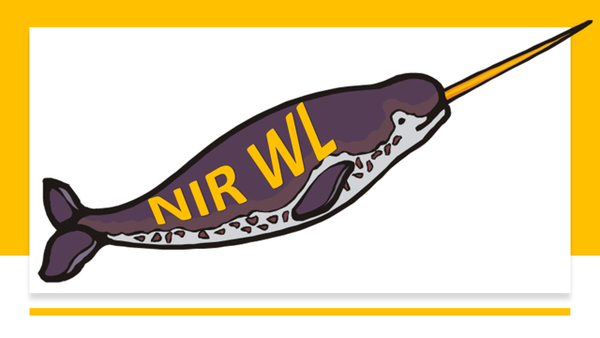
NIRWL
Near-Infrared Weak Lensing To Measure the Mass of Overdensities at z>1
Measuring weak gravitational lensing (WL), a powerful probe of the distribution of dark matter, is one of the primary science goals of the next decade of large extragalactic surveys with LSST, Euclid, SKA and WFIRST. Currently, however, the WL analysis has primarily been on optical-band data (e.g. HST/ACS, DES, and HSC- SSP). Near-infrared (NIR) imaging has thus far never been used for wide-field weak lensing measurement although it is now well-known that it provides superior galaxy shape measurements at z > 1 due to morphological k-correction. NIRWL aims to present the first galaxy shear catalog with the largest set of archival NIR images from the two widest HST/WFC3 surveys: CANDELS and COSMOS-DASH. Our program will aim to 1) test the fidelity of the resultant NIR WL map of dark matter in COSMOS with existing, optically- derived maps, 2) reveal galaxy over-densities at z > 1 in clusters/groups which are otherwise unknown due to photometric redshift uncertainties, 3) derive stellar/baryonic to dark matter mass ratios at z >1. Measuring these ratios on group and low-mass cluster scales will trace the relationship between the growth of large scale structure and the buildup of stellar mass thereby allowing a more complete understanding of galaxy evolution, and comparison with cosmological models over a relatively understudied redshift range. Due to the exceptional depth and spatial resolution of HST, and by leveraging the current state-of-the-art understanding of NIR detector/PSF systematics, our program will serve as a critical stepping stone for NIR WL science in upcoming surveys, with Euclid and Roman.
More Information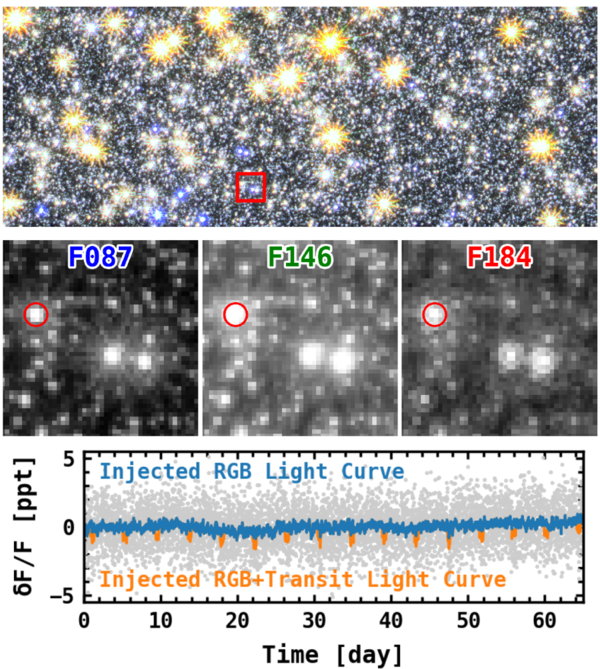
Transiting Exoplanets with Roman
NExScI at IPAC has partnered with GSFC and other university institutions to develop the infrastructure necessary to conduct an exoplanet transit survey with the Roman Galactic Bulge survey. The Roman Galactic Bulge survey, designed to find exoplanets through microlensing, will also detect 10s of thousands of transiting exoplanets – these transiting exoplanets can be used to study demographics of exoplanets in various galactic environments and the multi-band Roman observations may be used to characterize potential planets. This program will develop simulated data products and the tools necessary to identify and verify transiting exoplanets in the dense environment of viewed towards the Galactic Bulge. All data and tools will be made available to the public in preparation for the Roman operations. The program also contains a strong diversity and inclusiveness component to engage local community college students.
More Information
UVCANDELS
Ultraviolet Imaging of the Cosmic Assembly Near-infrared Deep Extragalactic Legacy Survey Fields
UVCANDELS is the definitive extragalactic UV imaging of the four premier HST deep-wide survey fields best suited to JWST observations. We will investigate the key processes of galaxy evolution during the epoch of vigorous star formation at 0.5 < z < 3 by: (1) Using the high spatial resolution UV and Blue data (700 pc at z~1) to study the structural evolution of galaxies and create 2D maps of their star-formation history. (2) Combining UVCANDELS with irreplaceable Herschel legacy data to trace the evolution of the dust content of moderate redshift (z < 1) galaxies. (3) Probing the role of environment in the evolution of low-mass star-forming galaxies. (4) Investigating the decay of star-formation in massive early type galaxies and the role of minor mergers. (5) Stacking images to constrain the escape fraction of ionizing radiation from galaxies at z~2.5 to better understand how star-forming galaxies reionized the Universe at z > 6.
More Information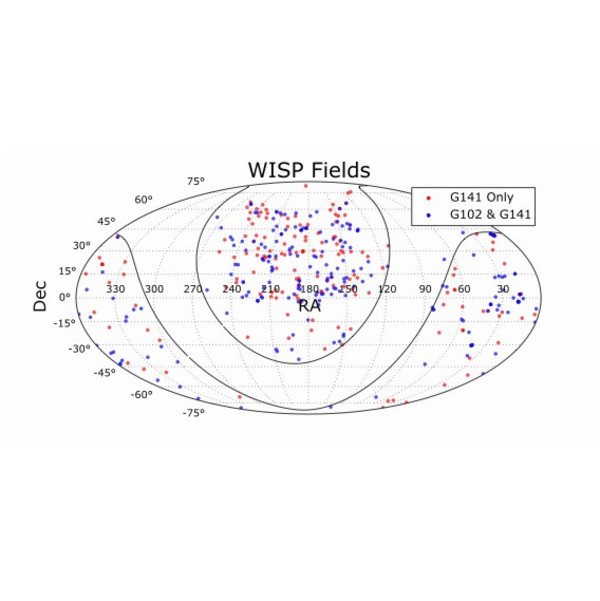
WISPS
WFC3 Infrared Spectroscopic Parallel Survey
The WISP survey is a large Hubble Space Telescope pure parallel program with the WFC3 G102 and G141 infrared grisms. The broad, continuous spectral coverage of the G102 and G141 grisms provides the best currently feasible measurement of the star formation rate continuously from 0.5 <z < 2.5. The primary WISP science goals are to: (1) measure the star formation history over the last 10 billion years; (2) probe galaxy clustering on Mpc scales at z=1-2; (3) constrain the evolution of dust extinction and metallicity as a function of mass and luminosity; (4) conduct a serendipitous search for highly luminous z >6 Ly-alpha emitters. The WISPs team includes several IPAC scientists, and data processing of images and spectra is carried out at IPAC. Further details can be found in the canonical paper: Atek et al. (2010).
More InformationLegacy Science Collaborations
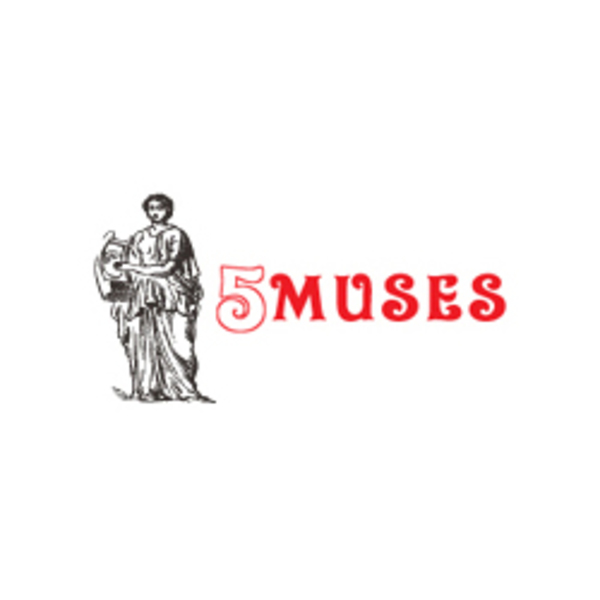
5MUSES
5mJy Unbiased Spitzer Extragalactic Survey
The 5mJy Unbiased Spitzer Extragalactic Survey (5Muses) is a mid-infrared spectroscopic survey of 330 galaxies with the Infrared Spectrograph (IRS) aboard Spitzer. 5MUSE bridges the gap between the bright, nearby infrared galaxies known before Spitzer, and the much fainter, more distant sources which have been the focus of much of the dedicated Spitzer IRS follow-up to date. The legacy of the 5Muses survey is a library of high quality IRS spectra that will be critical for providing: (1) a statistically complete accounting of the relative contribution of stars and AGN in IR-bright galaxies; (2) an overview of the prevailing physical conditions in the dusty ISM in galaxies over the past 2-5 Gyr; (3) proper modeling of the number counts and backgrounds in the infrared out to z=1, and a critical resource for future missions like WISE, Herschel and JWST. 5Muses is a Spitzer Legacy Science program led by IPAC’s director George Helou and a diverse team of scientists at IPAC.
More Information
Euclid/WFIRST Spitzer Legacy Survey
The Euclid/WFIRST Spitzer Legacy Survey program is a precursor survey for Euclid, WFIRST, and JWST. Led by Dr. Peter Capak from IPAC, an international team was awarded 5286 hours of Spitzer Legacy Science Time to observe 20 square degrees with 2 hours per pointing split between the Chandra Deep Field South (CDFS) and the North Ecliptic Pole (NEP). This will achieve 5-sigma depths of 24.6 AB mag and enable scientific research on reionization in the Universe, z>7 galaxy formation, and the first massive black holes. The survey parameters are designed to enable stellar mass measurement at 3<z<10, probe the large scale structure of reionization, and find luminous quasars to the highest redshifts where they exist. The depth and area of the survey is truly unique and will not be superseded for decades. Only Spitzer can probe this region of survey space at 3-5um, a wavelength range that uniquely enables stellar mass estimates at z>3 enabling a direct probe of galaxy growth during the epoch of re-ionization. The proposed data will also enhance the cosmological constraints provided by Euclid and WFIRST.
More Information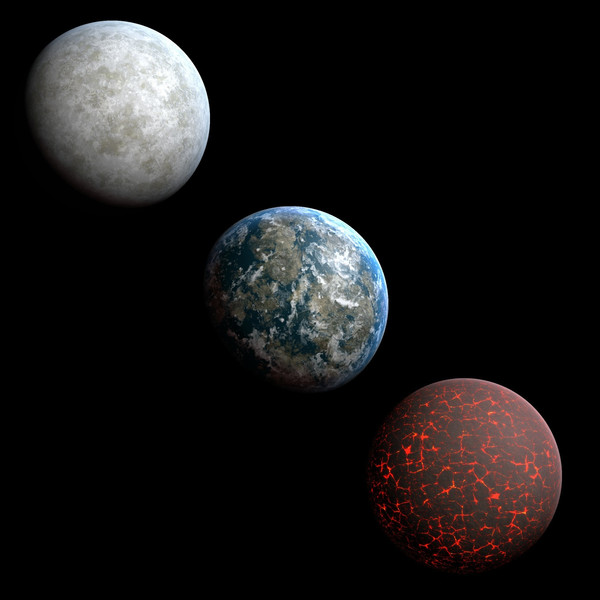
Habitable Zone Gallery
The Habitable Zone Gallery (www.hzgallery.org) was created by IPAC scientists Dawn Gelino and Stephen Kane as a service to the exoplanet community which provides Habitable Zone (HZ) information for each of the exoplanetary systems with known planetary orbital parameters. The service includes a sortable table with information on the percentage of orbital phase spent within the HZ, planetary effective temperatures, and other basic planetary properties. In addition to the table, there are also plots of the period and eccentricity of the planets with respect to their time spent in the HZ, and a gallery of known systems with plots of the orbits and the location of the HZ with respect to those orbits.
More Information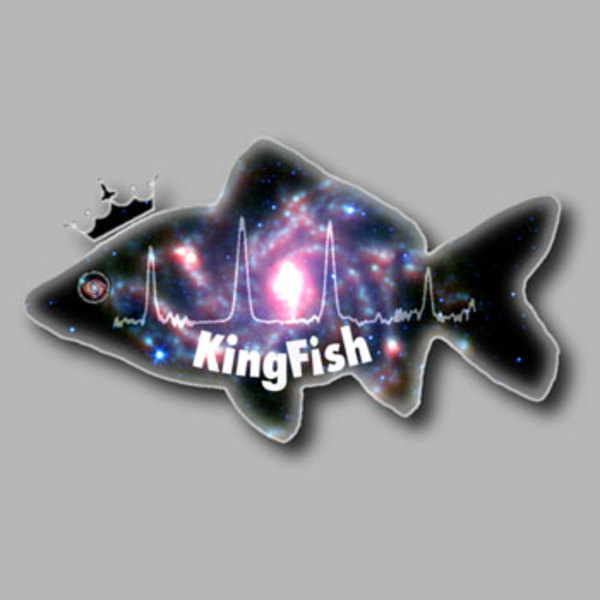
KINGFISH
Key Insights on Nearby Galaxies: a Far-Infrared Survey with Herschel
The Key Insights on Nearby Galaxies: a Far-Infrared Survey with Herschel (KINGFISH) project was selected as a Herschel Open Time Key Programme in cycle 1 to provide the Herschel community with a comprehensive library of far-infrared imaging and spectral line maps of local galaxies and their principal infrared emitting components, all integrated with the extensive multi-wavelength dataset from the Spitzer Infrared Nearby Galaxies Survey (SINGS). IPAC researchers are part of a large international collaboration that has jointly developed the KINGFISH imaging and spectroscopic survey which covers the full range of integrated properties and local interstellar medium (ISM) environments found in the local Universe for 61 nearby (d < 30 Mpc) galaxies. The broad goals of KINGFISH are to characterize the interstellar media of present-day galaxies, investigate the heating and cooling of their gaseous and dust components, and better understand the physical processes linking star formation to the ISM.
More Information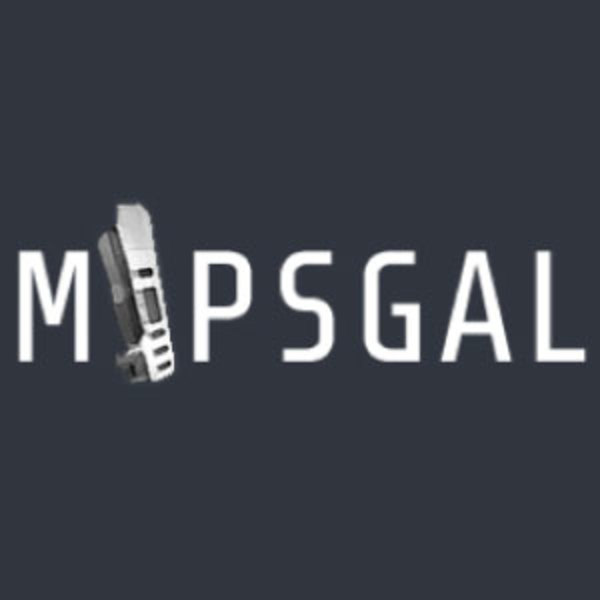
MIPSGAL I&II
A Spitzer Legacy Science program, MIPSGAL I is a survey of the inner 248 square degrees of the Galactic plane at 24 and 70 microns using the MIPS instrument aboard the Spitzer Space Telescope. MIPSGAL is used to tackle many unanswered questions, such as (1) the detailed energetics and distribution of the small silicate particles and hydrocarbon molecules comprising the interstellar dust in our galaxy and (2) how the most massive stars form. While this survey only covers 0.7% of the sky, most of the stars, gas and dust that make up our own Galaxy are imaged by these observations. MIPSGAL II is a 72 square degree survey of the innermost Galactic disk which connects the two fields observed by MIPSGAL I, and it is also complementary to the GLIMPSE II and proposed GLIMPSE 3D Spitzer Legacy surveys. This data finishes the census of massive star formation inside the molecular ring, provides detailed information on the distribution and energetics of small dust grains toward the nucleus of our Galaxy, and identifies all massive evolved stars in the surveyed portion of the Galactic bulge. MIPSGAL I & II data is hosted by IRSA at IPAC, including the raw observations from Spitzer in the Spitzer Heritage Archive, as well as a set of enhanced data products and tools.
More Information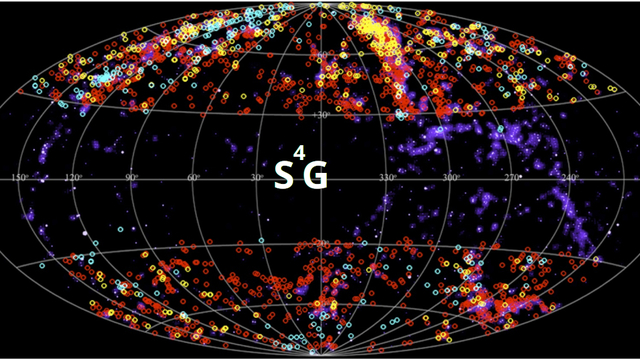
S4G
Spitzer Survey of Stellar Structure in Galaxies
The Spitzer Survey of Stellar Structure in Galaxies (S4G) is a volume-, magnitude-, and size-limited (d < 40 Mpc, |b|> 30°, m_Bcorr < 15.5, and D_25 > 1) sample of 2,352 galaxies, which have been mapped with IRAC channels 1 and 2 (3.6 and 4.5 microns). A follow-up survey added 465 early-type galaxies, bringing the total to 2,817 galaxies. This large, unbiased, and extremely deep sample of all Hubble types from dwarfs to spirals to ellipticals allows for detailed structural studies, not only as a function of stellar mass, but also as a function of the local environment. An extension of visible light images of 425 additional gas-poor late-type galaxies is currently being incorporated into the sample.
More Information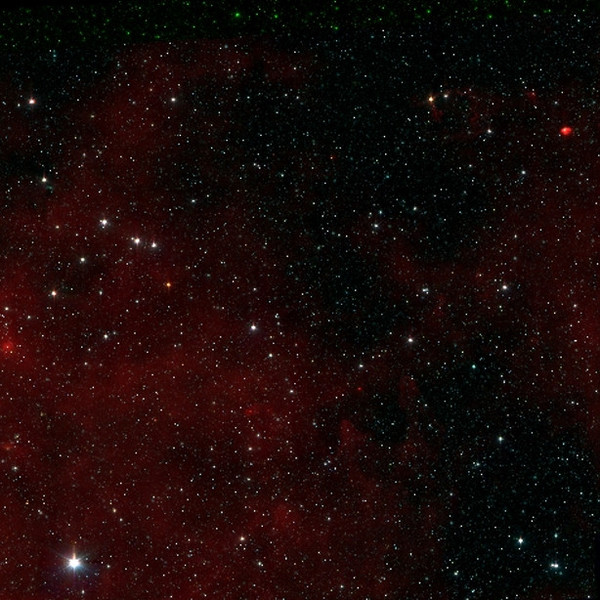
SMOG
Spitzer Mapping of the Outer Galaxy
The Spitzer Mapping of the Outer Galaxy (SMOG) was envisioned by its principal investigator, IPAC scientist Sean Carey and it is one of the selected Spitzer Legacy Science programs in cycle 5. SMOG is a 21 square degree area mapping of a representative region of the outer Galaxy (l=102-109, b=0-3) using Spitzer's IRAC and MIPS instruments. These data combined with previous and future surveys in the submillimeter and millimeter wavelength ranges can be used to measure the specifics (rate, IMF) of star formation. This direct measurement of the star formation efficiency can contribute to the large body of knowledge on the inner Galaxy, nearby molecular clouds and massive star forming regions, the Magellanic clouds and galaxies at larger distances. SMOG provides a set of optimally reduced mosaics and well-characterized source catalogs to the scientific community and just like previous large Spitzer local group mapping programs (GLIMPSE, MIPSGAL & SAGE) it will be a fertile source for studying such topics as evolved stars, Galactic structure, dust physics and the diffuse ISM.
More Information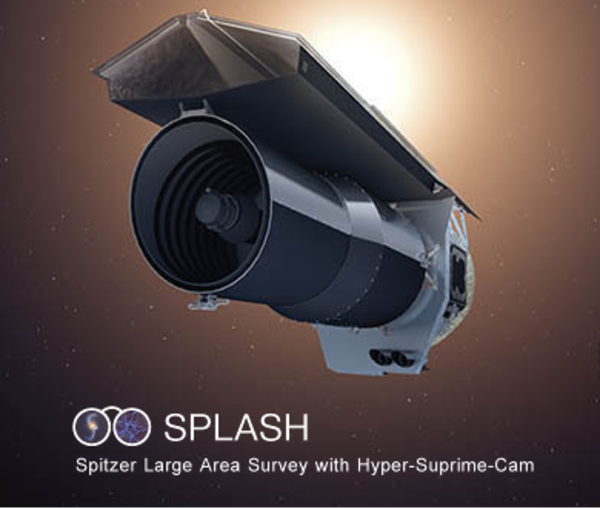
SPLASH
Spitzer Large Area Survey with Hyper-Suprime-Cam
The Spitzer Large Area Survey with Hyper-Suprime-Cam (SPLASH) is an astronomical survey to investigate the co-evolution of cosmic large-scale structure, dark matter and the assembly and growth of galaxies as well as supernovae in the early Universe through transient studies. The survey covers two 1.8 square degree fields (COSMOS and SXDS) and provides optical (from the Hyper-Suprime-Cam on the Subaru telescope) and mid-infrared (from the Spitzer Space telescope) imaging at an unprecedented depth over this area. SPLASH is being led by scientists at IPAC and thus provides an important connection between IPAC and the Hyper-Suprime-Cam collaboration, which is the pre-cursor of Large Synoptic Survey Telescope (LSST) and uses the same software pipeline.
More Information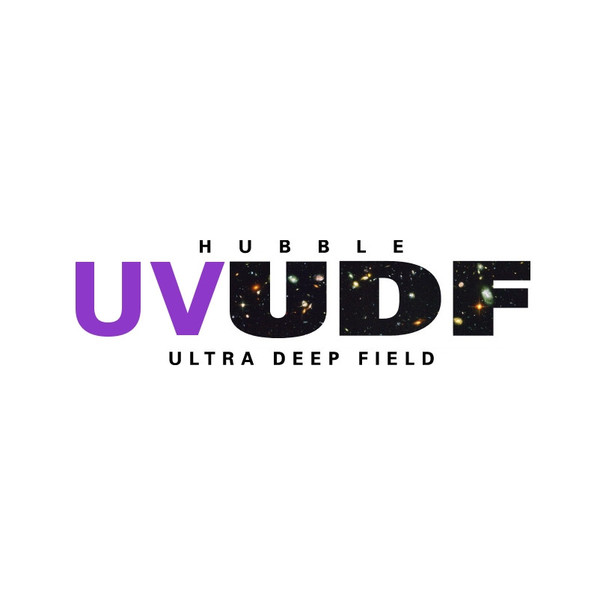
UVUDF
Panchromatic Hubble Ultra Deep Field: Ultraviolet Coverage
The Panchromatic Hubble Ultra Deep Field: Ultraviolet Coverage (UVUDF) is a treasury Hubble Space Telescope program using the WFC3-UVIS detector with the F225W, F275W, and F336W filters. These UV images will reach point source detection limits of AB=29, a factor of ten fainter than the GALEX ultradeep surveys. The project’s PI is IPAC’s scientists Harry Teplitz who oversees the source extraction and analysis of images which are carried out at IPAC. The primary UVUDF science goals are: (1) investigate the episode of peak star formation activity in galaxies at 1 < z < 2.5; (2) study the star formation properties of moderate redshift starburst galaxies; (3) probe the evolution of massive galaxies by resolving sub-galactic units (clumps); (4) examine the escape fraction of ionizing radiation from galaxies at z~2-3; (5) measure the star formation rate efficiency of neutral hydrogen gas at z~1-3.
More Information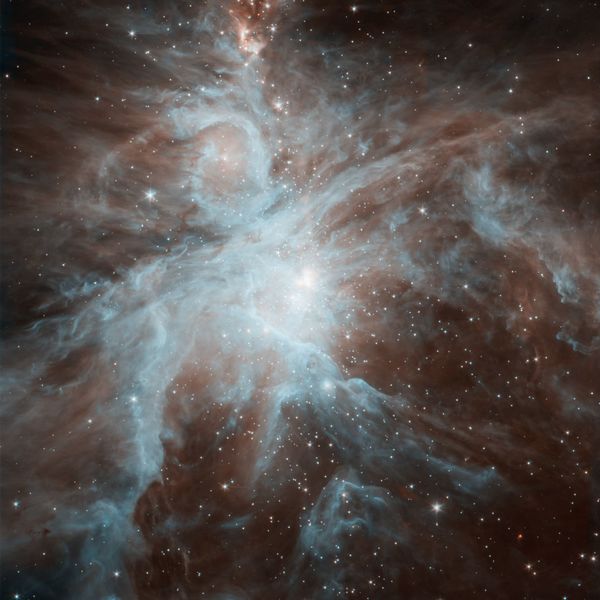
YSOVAR
Young Stellar Object Variability
The Young Stellar Object Variability project (YSOVAR) is led by IPAC scientist John Stauffer as one of Spitzer Exploration Science programs conducted during the warm mission with the InfraRed Array Camera (IRAC). Spitzer/IRAC has carried out an extensive, accurate time series photometric monitoring survey of star-forming regions in the thermal infrared allowing measurement of the relative fluxes of YSO's down to the substellar mass limit to 1-2% accuracy in star-forming regions out to >500 pc. YSOVAR provides a time series monitoring exploration science survey of the Orion Nebula Cluster and 11 very young, populous embedded star-forming cores. These are complemented by contemporaneous optical and near-IR monitoring data in order to allow comparison of the phase, amplitude and light-curve shape as a function of wavelength. These data can be used to: (1) provide otherwise unobtainable constraints on the structure of the inner disks in Class I and II YSOs - and hence, perhaps, provide clues to the formation and migration of planets at young ages; (2) measure the short and long-term stability of hot spots on the surfaces of YSO's of all evolutionary stages; (3) determine rotational periods for the largest sample to date of Class I YSO's and hence obtain the best measure of the initial angular momentum distribution of young stars.
More Information

